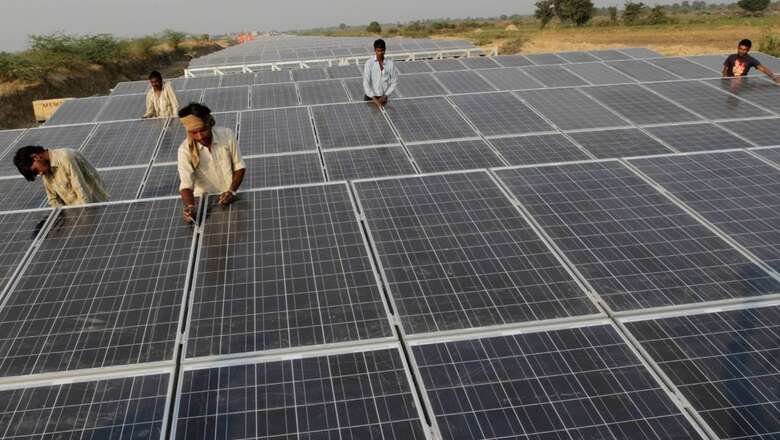
views
As momentum grows for the world to eventually turn away from fossil fuels to arrest the impact of climate change, India’s solar energy sector is being recognised for its potential around the world. According to a Wood Mackenzie report, India is set to emerge as the second-largest producer of solar modules by 2025. This is significant as India is slowly breaking China’s monopoly in the sector. China has an 80 per cent global share in the solar module supply chain. However, India is now taking on the dragon, and the results – which are still in the initial stages – look extremely promising.
Add to that, the capacity addition in India’s solar manufacturing sector is poised to primarily cater to US demand. Already, the US accounts for nearly 93 per cent of India’s solar PV exports.
While India’s own capacity to manufacture solar modules is rising fast, it is being complemented by a simultaneous reduction in imports of such modules from China. India’s solar module imports from China reduced nearly 80 per cent by $2 billion in the first half of 2023, according to think tank Ember.
In the previous fiscal (FY 2022-23), imports of solar cells, parts and diodes from China dropped 70 per cent, according to a report by the Delhi-based Global Trade Research Initiative. In fact, Ember also found that in the first half of 2023, India, alongside the European Union, contributed 12 per cent to the global increase in solar energy generation. Another study by Icra has predicted that India’s solar photovoltaic (PV) module manufacturing capacity is likely to increase to over 60 GW by 2025 from the current level of 37 GW. Another report by CII-EY estimates that the capacity is set to exceed 110 GW by 2026 as the results of a slew of government interventions in the sector become apparent.
Additionally, a series of projects will be completed in the next few years, contributing to a rise in India’s PV module manufacturing capacity. The CII-EY report notes that projects worth approximately 90 GW of PV cell and module capacity are under various stages of construction in India. Separately, around 68 GW of cell capacity is under different stages of implementation.
Meanwhile, the Institute for Energy Economics and Financial Analysis (IEEFA) expects that by 2026, India will not only reach the self-sufficiency target of 110 GW, but also have “a significant presence in all aspects of PV manufacturing, including cells, ingots/wafers and polysilicon.” By the end of the current financial year, India is expected to add 16 to 17 GW of solar capacity to its kitty. Considering the fact that India added 13.9 GW and 12.8 GW of solar capacities respectively over the past two financial years, the current fiscal’s capacity addition may just be a historic high. Between March 2018 and October 2023, India’s solar power witnessed a three-fold increase from 22.34 GW to 72 GW. India aims to have an installed solar power capacity of 280 GW by 2030, which means the country needs to add about 27 GW annually. So, a lot of scaling up still remains.
The rise in India’s solar capacity is also producing impressive results on the jobs front. According to a report by IRENA, grid-connected solar PV jobs in India rose by 47 per cent in 2022, reaching a total of 201,400 positions. Around 80,000 individuals were employed in the off-grid solar segment. Last year, an additional 52,100 solar industry jobs were created, with most positions opening in the project development space.
The bottom line is this: India’s solar energy sector is today becoming a subject of interest around the world, and various institutions involved in this space are bullish about the rise of an Indian solar energy ecosystem. The rise in solar industry jobs also highlights the increased activity in the sector, especially in project development. Whether it be capacity additions in solar energy itself, or the associated manufacturing sector, India appears to be hitting the right notes on both fronts.
What is Enabling the Rise of India’s Solar Energy Sector?
The government of India has taken a series of measures in recent years to boost not just the share of solar power in the country’s energy basket, but also to radically increase India’s share in global solar manufacturing. Perhaps the move which has had the most profound impact on the sector is the Centre’s decision to impose a 40 per cent basic customs duty on solar modules and 25 per cent on solar cells. However, more structural initiatives have played a crucial role as well, and these are helping India’s long-term aim of dominating the solar energy sector – after achieving self-sufficiency, of course.
Among these initiatives, the Approved List of Models and Manufacturers (ALMM) stands out. The ALMM mandate was introduced in 2021 as a non-tariff barrier to boost domestic manufacturing, by approving the list of indigenous models and manufacturers who could participate in solar development projects bid out by the government. Before the imposition of ALMM, Chinese manufacturers supplied 85 per cent of India’s panel demand. The mandate has played a pivotal role in stopping the overflow of Chinese models in Indian markets.
Realising that a sudden imposition of such a rule could stall ongoing projects – and it did, to an extent, the Centre had issued an exemption for ongoing solar projects from the mandatory rule until March 2024.
Another mega move by the Modi government, in the form of a production-linked incentive (PLI) scheme, has infused new energy into India’s solar manufacturing sector. With an outlay of Rs 25,000 crore, the PLI scheme aims to build an ecosystem for manufacturing of high-efficiency solar PV modules in India and thus reduce the country’s import dependence. The government has listed several other objectives, such as:
- To build solar PV manufacturing capacity of high-efficiency modules
- To bring cutting-edge technology to India for manufacturing high-efficiency modules
- To promote the setting up of integrated plants for better quality control and competitiveness
- To develop an ecosystem for sourcing local material in solar manufacturing
- Employment generation and technological self-sufficiency
So far, the Modi government has incentivised the Indian PV industry to the tune of approximately $3.2 billion over two tranches. In March this year, 11 companies were allocated 39,600 MW of domestic solar PV module manufacturing capacity with an outlay of Rs 14,007 crore.
Needless to say, challenges persist. For starters, India is not performing up to the mark when it comes to rooftop solar systems, in the sense that the uptake of such systems remains low. According to the Ministry of New and Renewable Energy, the cost of installing a 1-2 KW system is about Rs 43,000 per unit – which many Indians still find quite expensive. Addressing this issue will help push demand for solar panels and associated systems which will give a fillip to Indian manufacturers.
Secondly, President Joe Biden’s Inflation Reduction Act in the United States, which has sweeping provisions to boost domestic renewable energy manufacturing in the US, is expected to also result in American manufacturers picking up production of solar power systems. That would be detrimental to India’s interests, which is why New Delhi must immediately begin seeking newer markets for its products.
Finally, India needs to double down on its efforts to strengthen and support the manufacturing of upstream components such as polysilicon, ingots/wafers, ancillaries, and PV machinery, which will help bring overall production costs down, thereby making Indian solar power systems more competitively priced against China’s.
India’s transition towards renewable energy sources will take time. However, that does not mean the transition is not already working. In fact, in the first half of 2023, India’s power sector emissions grew by 3.7 per cent. That represents a significant fall from the growth witnessed last year when the figure stood at 9.7 per cent. Essentially, India prevented the release of an additional 11 million tonnes of CO2 in the first six months of this year. This shows that India’s push for cleaner energy sources is beginning to have an impact.
Views expressed in the above piece are personal and solely that of the author. They do not necessarily reflect News18’s views.


















Comments
0 comment